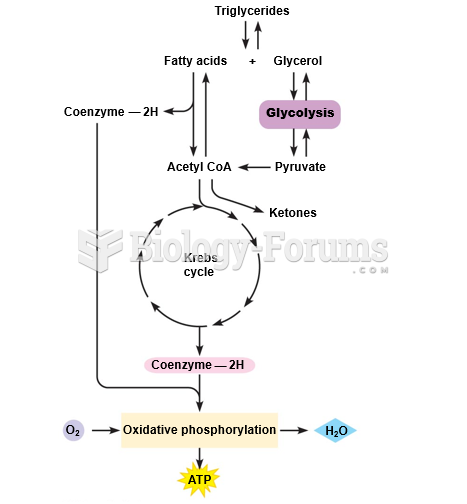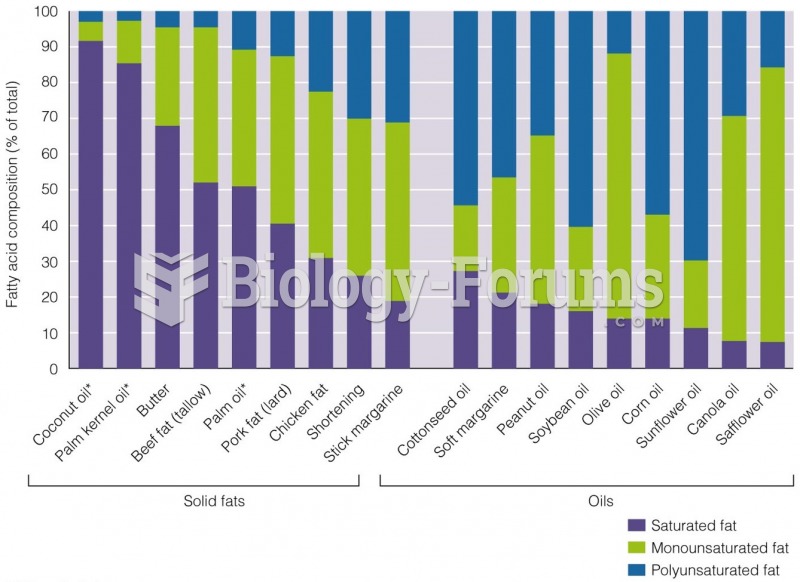Answer to Question 1
As mentioned earlier, elevated LDL cholesterol is a major risk factor for cardiovascular disease (CVD). As LDL cholesterol accumulates in the arteries, blood flow becomes restricted and blood pressure rises. The consequences are deadly; in fact, heart disease is the nation's number-one killer of adults. LDL cholesterol is often used to predict the likelihood of a person's suffering a heart attack or stroke; the higher the LDL, the earlier and more likely the tragedy. Much of the effort to prevent and treat heart disease focuses on lowering LDL cholesterol.
Saturated fats are most often implicated in raising LDL cholesterol. In general, the more saturated fat in the diet, the more LDL cholesterol in the blood. Not all saturated fats have the same cholesterol-raising effect, however. Most notable among the saturated fatty acids that raise blood cholesterol are lauric, myristic, and palmitic acids (12, 14, and 16 carbons, respectively). In contrast, stearic acid (18 carbons) seems to have little or no effect on blood cholesterol. Making such distinctions may be impractical in diet planning, however, because these saturated fatty acids typically appear together in the same foods. In addition to raising blood cholesterol, saturated fatty acids contribute to heart disease by promoting blood clotting. Fats from animal sources (meats, milk, and milk products) are the main sources of saturated fats in most people's diets. Selecting lean cuts of meat, skinless poultry, and fat-free milk products helps to lower saturated fat intake and the risk of heart disease.
Research also suggests an association between dietary trans fats and heart disease. In the body, trans fats alter blood cholesterol the same way some saturated fats do: they raise LDL cholesterol and lower HDL cholesterol. Limiting the intake of trans fats can improve blood cholesterol and lower the risk of heart disease. To that end, many restaurants and manufacturers have taken steps to eliminate or greatly reduce trans fats in foods. The decrease in trans fatty acids in the food supply is apparent in a decrease in plasma concentrations of trans fatty acids in consumers.
Unlike saturated fat and trans fat, dietary cholesterol raises blood cholesterol very little, if at all. Less clear is its role in heart disease.
Replacing saturated fats with unsaturated fats reduces LDL cholesterol and lowers the risk of heart disease. To replace saturated fats with unsaturated fats, saut foods in olive oil instead of butter, garnish salads with sunflower seeds instead of bacon, snack on mixed nuts instead of potato chips, use avocado instead of cheese on a sandwich, and eat salmon instead of steak.
Research on the different types of fats has spotlighted the many beneficial effects of the omega-3 polyunsaturated fatty acids. Regular consumption of omega-3 fatty acids may help to prevent blood clots, protect against irregular heartbeats, improve blood lipids, and lower blood pressure, especially in people with hypertension or atherosclerosis. In addition, omega-3 fatty acids support a healthy immune system and suppress inflammation.
A diet that uses olive oil instead of other fats, especially butter, stick margarine, and meat fats, offers numerous health benefits. Olive oil, canola oil, and other oils rich in monounsaturated fatty acids help to protect against heart disease and stroke by:
Lowering total and LDL cholesterol and not lowering HDL cholesterol or raising triglycerides
Lowering LDL cholesterol susceptibility to oxidation
Lowering blood-clotting factors
Providing phytochemicals that act as antioxidants
Lowering blood pressure
Interfering with the inflammatory response
Tree nuts and peanuts are traditionally excluded from low-fat diets, and for good reasons. Nuts provide up to 80 percent of their kcalories from fat, and a quarter cup (about an ounce) of mixed nuts provides more than 200 kcalories. Frequent nut consumption (1-ounce serving of nuts on five or more days a week), however, protects against heart disease.
Research into the health benefits of the long-chain omega-3 poly-unsaturated fatty acids began with a simple observation: the native peoples of Alaska, northern Canada, and Greenland, who eat a traditional diet rich in omega-3 fatty acids, notably EPA (eicosapentaenoic acid) and DHA (docosaheaenoic acid), have a remarkably low rate of heart disease even though their diets are relatively high in fat. These omega-3 fatty acids help to protect against heart disease by:
Reducing blood triglycerides
Stabilizing plaque
Lowering blood pressure and resting heart rate
Reducing inflammation
Serving as precursors to eicosanoids
Research also suggests an association between dietary trans fats and heart disease. In the body, trans fats alter blood cholesterol the same way some saturated fats do: they raise LDL cholesterol and lower HDL cholesterol. Limiting the intake of trans fats can improve blood cholesterol and lower the risk of heart disease. To that end, many restaurants and manufacturers have taken steps to eliminate or gr
Answer to Question 2
When meals deliver more energy than the body needs, the excess is stored as fat in the adipose cells for later use. An enzymelipoprotein lipase (LPL)hydrolyzes triglycerides from circulating lipoproteins, releasing fatty acids, diglycerides, and monoglycerides into the adipose cells. Enzymes inside the adipose cells reassemble these fatty acids, diglycerides, and mono-glycerides into triglycerides again for storage.
After meals, the blood delivers chylomicrons and VLDL loaded with triglycerides to the body's cells for energy. Fat supplies about 60 percent of the body's ongoing energy needs during rest.
During prolonged light to moderately intense exercise or extended periods of food deprivation, fat may make a slightly greater contribution to energy needs. During energy deprivation, several lipase enzymes (most notably hormone-sensitive lipase) inside the adipose cells respond by dismantling stored triglycerides and releasing the glycerol and fatty acids directly into the blood. Energy-hungry cells anywhere in the body can then capture these compounds and take them through a series of chemical reactions to yield energy, carbon dioxide, and water.
A person who fasts (drinking only water) will rapidly metabolize body fat. Even with abundant fat supplies, the person has to obtain some energy from lean protein tissue because the brain, nerves, and red blood cells need glucoseand without carbohydrate, only protein and the small glycerol molecule of a triglyceride can be converted to glucose; fatty acids cannot be. Still, in times of severe hunger and starvation, a fatter person can survive longer than a thinner person thanks to this energy reserve.







